Behind the scenes of the Cyclone Loop
July 21, 2018
With thousands of cyclists riding through Iowa towns every summer for RAGBRAI, volunteers and planning are essential to the event.
This year Ames is one of those towns on the route, hosting cyclists on July 24. The last time Ames landed on the RAGBRAI route was 2008.
Ames added a special route this year with the “Cyclone Loop.” The loop sends riders through the inside of Jack Trice Stadium.
“We’re very excited to have the riders ride into Jack Trice Stadium with the scoreboard on and have a great finish to a day like today,” said Iowa State athletic director Jamie Pollard at the Cyclone Loop announcement on June 5.
The RAGBRAI riders will be able to cruise through the Cyclone Loop from 10 a.m. to 6 p.m. on July 24.
While the loop provides an inside look to Jack Trice Stadium, the set up for it didn’t happen overnight.
The RAGBRAI route was released at the end of January. With the route reveal, the staff at Think Ames began to prepare.
“Collectively, the office started planning the events right in January when they got the bid,” said Liz Kurt, the head of the Cyclone Loop committee.
The Think Ames staff wanted to do something special to commemorate RAGBRAI passing through, so they explored multiple options.
Julie Weeks, the President and CEO of Think Ames, said that they communicated with Iowa State and the City of Ames early on to find a unique feature of Ames to showcase.
“Before we understood the complete route, we looked at opportunities on campus, itself,” Weeks said. “We looked at Ada Hayden Park, we looked at south Ames, we looked at doing something south of Jack Trice — at Reiman (Gardens) or the research park.”
Ultimately, the committees ruled out Reiman Gardens and the south parts of Ames based on the flow of traffic in the city, so they settled on Jack Trice Stadium being the focal point.
Once going past Jack Trice Stadium was in the plan, Weeks and her staff talked with the Iowa State Athletic Department about utilizing the inside of the stadium.
After the Cyclone Loop was established, Kurt gathered volunteers and vendors around the stadium.
Kurt plans on having between 25 and 30 people working per shift at the Cyclone Loop. Kurt will use the assistance to help organize and control the riders to prevent over-congestion on the loop, along with the set up beforehand.
“It involves quite a bit of set up,” Kurt said. “We’re working heavily with athletics, the city, Iowa State University preparing the area. There’ll be an entire section of food vendors at the Cyclone Loop as well because riders will coming in, and they’ll be looking for something to eat and drink.”
The food vendors around the route adds another element of preparation. Kurt has to communicate with the vendors about where and when they’ll be setting up, and if they’ll be selling merchandise or food.
Gathering enough commitments from vendors hasn’t been much of a problem, though. Kurt said that a majority of the vendors she’s talked to have contacted her and her team first.
While you view the riders either in person or online, don’t forget to remember all the hours of work going into the event to make it happen.
















